Accelerated Test of Silicone Rubbers Exposing to PEMFC environment
Dijun Yng ,Jingwen M ,Qing Zhng ,Bing Li,* ,Pingwen Ming ,Cunmn Zhng
a Clean Energy Automotive Engineering Center,Tongji University,China
b School of Automotive Studies,Tongji University,China
ABSTRACT The durability of sealing material is one of the major challenges to the overall lifetime of proton exchange membrane fuel cell(PEMFC).In order to study the failure mode and aging mechanism of fuel cell seals,this paper focuses on the most widely used commercial silicone rubber,and an ex-situ accelerated aging method was employed by simulating the circumstance of PEMFC,including higher temperature and clamping force,lower pH value and F- with higher concentration.The main factors that affect the performance of the seal were obtained through the test of their morphologies and mechanical properties.The failure mode of the aging mechanism of the rubbers were analyzed through scanning electron microscopy (SEM),energy dispersive spectrometer (EDS),attenuated-total-reflection infrared spectroscopy(ATR-IR),mass loss,compression set(CS),etc.It was found that temperature played an important role in the deterioration of seal performance,and the change of the parameters of the compression set with time conformed the dynamic empirical formula,which provides the experimental basis for the lifetime prediction of the seals.
Keywords:PEMFC Sealing material Simulating experiment Durability Lifetime prediction
1.Introduction
Proton exchange membrane fuel cell(PEMFC)is an important device closely related to hydrogen,which has extensive sources and has been reckoned as new energy as an alternative of fossil fuels.In China PEMFC powered new energy vehicles (NEVs) have been given more incentives than battery NEVs [1].In the period from 1990s to 2010,the development of fuel cell stack was typically focused on its vehicle integration,feasibility and environment adaptability.From 2010 on,auto manufactures came to improve the power density of fuel cell stack,even to the highest 3.1 kW/L as showcased by Toyota’s Mirai,which is totally competitive to conventional internal combustion engine (ICE).However,precede the real commercialization of fuel cell NEVs,the durability issue of PEMFC has to be solved to make it more competitive.Many efforts have been made to improve the durability of PEMFC,mostly including membrane [2],electrocatalyst [3] and support [4],gas diffusion media[5],bipolar plate[6],as well as driving cycles[7]and contaminations [8].However,besides the main components attracting numbers of researches,the reliability and lifetime of sealing components should be investigated thoroughly.That is because normally a lot of sealing materials are included in a fuel cell stack and they possess a critical function by separating the reactant gases and coolant from each other and the external circumstance as well (Fig.1).
Reliable seals can provide a PEMFC an efficient sealing performance and safe operation.Materials used in PEMFC are usually elastomers,such as polyacrylate,acrylate copolymer,butyl,neoprene,silicone,ethylenepropylene-diene-monomer (EPDM),etc.For better resistance to hydrogen,oxygen,water,and heat,fluorine-containing elastomers,like fluorosilicone,are also preferred.All the elastomers should possess sufficient chemical and mechanical resistance against the stressing environment of PEMFC,i.e.temperature,certain pH value,in the presence of F-,as well as compressive force.Therefore the durability of the materials can be judged by the chemical transformation with detectable small molecular substance or spectroscopy changes.Mechanical performance degradation,like enlarged compression set and weakened tensile strength,can also be employed to assess the elastomeric materials’performance.
Silicones rubbers are based on polydimethylsiloxane(PDMS)having a siloxane (Si-O-Si) repeat unit and two methyl groups,which is assumed durable and hard to degrade naturally in the environment[9],even durable to strengthened UV light [10] and high voltage direct current (HVDC) [11].
In-situ test within a PEMFC may provide direct insight into the inner factors affecting the overall performance.An early published paper[12]described a 7 cell stack failure due to gasket degradation.In this stack,a precision grade silicone material were cut for the bipolar plate,and crossover leakage has been found during the stack operation,and was considered to be the root reason for the failure.Schulze et al.[13] reported the degradation of silicone-red®seals,which should maintain its integrity up to 220°C,with a small single cell.With X-ray analysis(EDX)and X-ray photoelectron spectroscopy (XPS) measurement,the degradation of the sealing material and its influence on gas diffusion layers(GDLs),catalyst layers (CLs) were verified.
Nowadays,for rapid screening or down selection of sealing materials,simulated fuel cell environment has been reckoned as a more efficient way,compared to real fuel cell experiments.Researchers in Loughborough University has conducted experiments by using elevated temperature (140°C),greater acidity (pH=1,2,4),and Nafion®membrane as the accelerated aging conditions[14].Also,Tan et al.have published a series of articles for ex-situ studying of the degradation of silicone rubber in a simulated PEM fuel cell environment [15,16] [[,]][17-19].Recently,Wu et al.[20] investigated the silicone rubber as gasket by cycling temperature from -20°C to 90°C,in simulated PEMFC environment solution,weak acid solution,de-ionized water and air respectively.
Among all the aforementioned materials,silicone rubber becomes the most commercially available one,because of its excellent workability,good flexibility to temperature change [21] and low cost.Meanwhile,reformative silicone rubbers are under development to cater for the demands of PEMFC industry.As a newly initiating industry,models to predict silicone rubber durability are inadequate.Although existing literature reports the chemical and mechanical durability of silicone rubber or others elastomers,transfer functions to move from ex-situ durability tests to in-service lifetime are absent.
Although,there is a large amount of literature discussing the degradation of silicone rubbers in various environments,no accelerated test has been conducted by combining elevated temperature and compression stress as the accelerated aging factor.In this paper,we report the results from an investigation of silicone rubber gaskets under compression and elevated 150-180°C.The objectives of this work are to(1)reveal the effect of combined accelerating factors on the degradation of silicone rubber,(2) provide a suitable test protocol for the rapid screening of various sealing materials within an affordable short term for PEMFC developers;(3)Determine the main parameters required for the establishment of seal lifetime prediction model.
2.Experimental
2.1.Specimen and device
The sealant used in this study was a commercial available silicone rubber,which is specially design for PEMFC and still under verification.The silicone rubber was a two-component material,which can be conveniently applied for the mass production of PEMFC seals,integrated with either bipolar plate or membrane electrode assemblies(MEAs).The application process normally was liquid injection molding(LIM)or curedin-place gasket (CIPG).The round specimens were cured in a die according to standard ASTM D395-16,with a thickness of 6 mm and a diameter of 13 mm.The dumbbell-shaped specimens were cut with a die,according to the type C described in ASTM standard D412-2015a.
For the simulation of the compression state the seal subjected in a real PEMFC,two types of clamping fixtures were designed (Fig.2).Polytetrafluoroethylene (PTFE) was found endurable in the harsh environment,which will be given in this paper,and adopted by the fixtures.For the round fixture,a 316 L stainless steel plate might be encapsulated within PTFE material to ensure better dimension stability.
A high-pressure reactor with a volume of 2 L was employed to prevent the volatilization of the accelerated aging solution soaking the seals,which can be held in a high-temperature oven to maintain its temperature for a long period of time.
All the specimens were tested under accelerated aging conditions.
2.2.Accelerated aging processes
In order to shorten the evaluation time of a sealing material,ex-situ accelerated aging test method are always used to compare different materials.With time-related information and understanding of degraded material,a lifetime prediction model can be developed.Compared to the literature,similar but different factors were adopted in terms of temperature,pressure,and soaking solution.
2.2.1.Temperature
It was found that the silicone rubber cured at 120°C was durable at the typical operation temperature of PEMFC,from 70°C to 80°C.For better accelerating effect,elevated temperatures of 90°C,120°C,150°C and 180°C were chosen.
2.2.2.Clamping force
Suitable clamping force is the most important factor during the stacking process of PEMFC for proper sealing performance.Normally a metal bipolar plate(BPP)stack will adopt higher clamping force than a graphite BPP one.Subjecting to long term compression in a stack,material fatigue,fold,even crack might occur.Compressive force equivalent to 0.5 MPa,1.0 MPa and 2.0 MPa were loaded to the seals by a universal material testing machine (3365,Instron),which covered almost all the possible working force within a PEMFC stack.
2.2.3.Accelerated aging solution
Sealing materials usually works in liquid erosive circumstance,which can be simulated with acid solution and in the presence of H-,F-,,even pieces of Nafion® membrane [14],etc.The silicone rubber specimens,after clamping with the fixtures,were immersed into the accelerated aging solution in a high-pressure,PTFE lined reactor,following the instruction of GB/T1690-2006.The aqueous solution was prepared with 10×10-6mol/L HF and 1 mol/L H2SO4.Both F-and H+concentration were higher than the real PEMFC circumstance,in order to accelerate the aging process.
2.3.Characterization methods
Mass loss,scanning electron microscopy (SEM) (Quanta 250 FEG,FEI),and attenuated-total-reflection infrared spectroscopy (ATR-IR)(iD7,Thermoscientific) energy dispersive spectrometer (EDS) (Genisis XM,EDAX) were used for the characterization of the silicone rubber’s change in terms of mass,surface morphology and chemistry,respectively.

Fig.1.Schematic of PEMFC’s structure.
Compression set (CS) is the property more relevant to sealing applications,and the degradation of the seal will cause the decrease of the compressive force between seal and its contacting surface,following by the increase of CS.CS was measured with a standard device according to ASTM D395 and can be calculated as follows,

whereCBis the compression set,t0is the original thickness,tiis the final thickness after aging,tnis the total thickness of spacers adopted to maintain the deformation rate of the seal.
3.Results and discussion
3.1.Surface morphology of the exposed silicone rubber by SEM
The Surface Morphology of the dumbbell-shaped silicon rubber specimens exposed under the pressure of 1.0 MPa,accelerated aging solution for 200 h in an oven at 120°C,150°C and 180°C respectively was characterized by scanning electron microscopy (SEM),and the results are shown in Fig.3.For comparison,the pristine specimen has also been tested.
The images were taken from the side faces of the silicone rubber specimens,which was directly contacted to the solution.The specimens were dried,cleaned and gold-plated prior to the SEM experiment.As shown in Fig.3 (a),except for some protuberances,the surface of the pristine specimen was smooth.However,some debris could be found at 120°C (Fig.3 (b)),and the specimens degraded with the increasing temperature.At 150°C(Fig.3(c))there were pits on the surface of the specimen,with obvious signs of corrosion and falling off from the material.At 180°C (Fig.3 (d)),the surface of the sample was seriously aged,with vertical and horizontal gullies.From Fig.3(e),it can be seen that the depth of the surface crack was about 30 μm.Considering the service lifetime of thousands of hours under the normal fuel cell environment of silicone rubber,it can be seen that its aging behavior was significantly accelerated by elevated temperature.
The aging of silicone rubber materials in PEMFC simulated solution environment is a complex process of surface chemical reaction,which is related to temperature,solution concentration,operating potential,reaction contact area and other factors.According to the chemical reaction kinetics,with the increase of temperature,the reaction coefficient will increase exponentially,which will increase the aging speed.At the same time,the aging reaction will cause surface coarsening or damage,increase the contact area of reaction,increase the number of defect points,or even go deep into the interior of the silicone rubber material to react,tear the rubber material again,and further accelerate the aging speed.The solution continuously destroys the surface of silicone rubber at high temperature,obtains larger contact area,and makes the reaction speed rise again.This progressive growth type reaction process explains the obvious accelerated aging process of silicone rubber from 120°C to 180°C.
3.2.Surface oxidation of the silicon rubber tested by ATR-IR
The surface property change of the aged silicon rubber specimen under the treatment condition of 120°C,1 MPa in the simulation solution for 230 h was characterized with ATR-IR,and the results are shown in Fig.4.For comparison the plot of the fresh one is also shown in Fig.4.It can be seen that the peaks of poly(dimethylsiloxane)from 600 to 1250 cm-1almost remained the same,even after 230 h exposure to the accelerated aging environment,implying a highly promising application of silicone rubber to be used in PEMFC.However,two peaks were shown from 2300 to 2380 cm-1,which can be attributed to vibration ofdue to the oxidation silicone molecular under the impact of temperature and water.
3.3.Mass loss
To measure the decomposition trend during the aging processes,round specimens were submerged in the solution with 1.0 MPa clamping force applied by the corresponding fixtures.The high pressure reactor with fixtures were put into the oven under 120°C,150°C and 180°C,respectively.The mass loss of the specimens were monitored after being taken out from the oven,and drying at room temperature (Fig.5).
It can be found in Fig.5 that the mass of the silicone rubber decreased with time.The abnormal increase from 50 h to 124 h under 120°C might be attributed to measurement error.In the accelerated aging solution,silicone rubber was corroded and damaged,pits or even large areas of damage and material falling off,which lead to the decline of rubber quality.It can also be seen from Fig.5 that the higher the temperature is,the more serious the mass loss of silicone rubber is,which is consistent with the phenomenon observed in section 3.1.At 180°C,the mass loss was about 3% after 230 h exposure.These flaked substances will enter the gas flow channel and attach to the gas diffusion layer(GDL),which will affect the hydrophobicity of GDL,thus causing water flooding and air flow obstruction of PEMFC [14];the substances dissolved in the liquid may also enter the catalytic layer and impact the activity of catalyst.On the other hand,the mass loss reflects the aging reaction and damage degree of silicone rubber.Serious aging and damage will lead to the decrease of sealing performance,and increase the probability of gas or coolant leakage.

Fig.2.Clamping fixtures for the compression of round (a) and dumbbell-shaped (b) specimens.
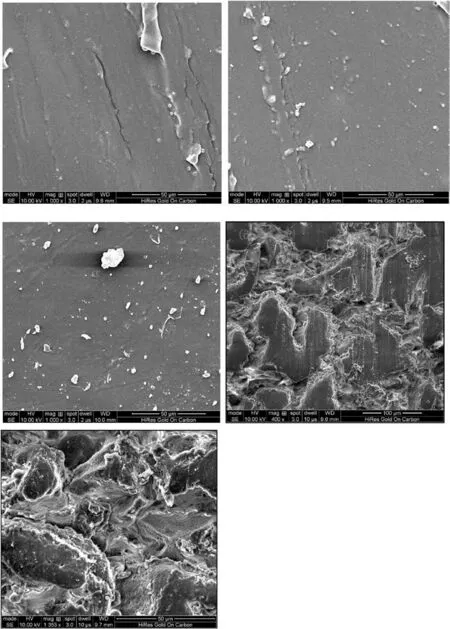
Fig.3.SEM images of the silicon rubber specimens after exposure under different temperatures for 200 h:(a)pristine(b)120 °C,(c)150 °C,(e)180 °C and(e)180 °C(enlarged image).
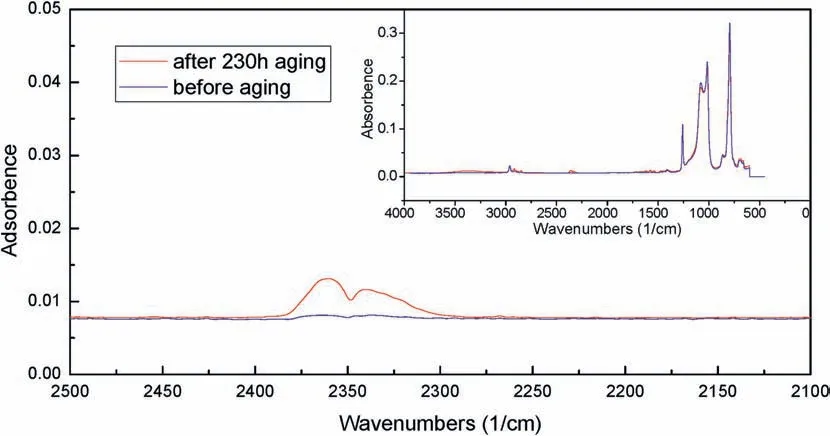
Fig.4.ATR-IR comparison between the fresh silicone rubber and the one aged for 230 h.
3.4.Mechanical strength change characterized by compression set
The change of compression set ratio can reflect the strength of molecular chain structure in rubber under the impact of external load.The more stable the molecular chain structure is,the smaller the compression set rate is.In the application of rubber as sealing material,because it is more in line with the working conditions,the compression permanent deformation is more applicable than the tensile performance,and it can reflect the mechanical properties of the seal more intuitively.
At 120°C,150°C and 180°C,1 MPa pressure was applied to the specimens with the fixtures,which were then immersed in the simulated aging solution.After a period of time,a specimen was taken out;the thickness of specimen was measured after cleaning and drying,and the compression set of the specimen could then be determined.
It should be noted that the method used for the measurement of CS in this paper is slightly improved on the basis of the standard method to make it more suitable for the service conditions of PEMFC seals.Compared with the standard method,a constant pressure (1 MPa) was applied onto the specimen.The height of the specimen decreased from 6 mm to about 3.9 mm,i.e.35% initial compression rate,which was higher than the standard test conditions,but in line with the compression state of the seal in PEMFC.The change of CS of silicone rubber with time in under different temperatures are shown in Fig.6.

Fig.5.Specimen mass loss with time under 120 °C,150 °C and 180 °C.
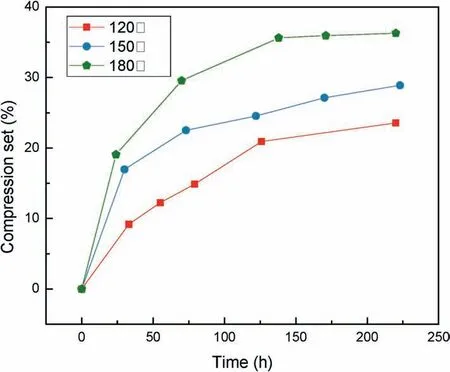
Fig.6.CS changed with time at different temperatures.
It can be seen from Fig.6 that the CS increases with time,and the higher the temperature,the greater the CS.At 120°C,the highest CS is about 23%,while at 180°C,the highest CS increase to over 35%,which means the silicone rubber has totally lost it elasticity.This shows that the increase of temperature has an obvious accelerating effect on the rubber’s mechanical properties.Therefore temperature might be used as the main factor for the prediction of the lifetime of PEMFC seals.
3.5.Element qualitative and quantitative change by EDS
In order to obtain more information of the degradation of the silicone rubber under accelerated aging conditions,the materials’ EDS was recorded during SEM examination.EDS is a surface analytical technique where the X-ray emitted from the specimen,after being hit by an electron beam,were collected.Different elements and their amount can be determined by the X-ray.By examining an area with a dimension of ca.134 × 100 μm of each specimen,the quantized results of element C,O and Si are recorded in Table 1.A pristine silicone rubber specimen was used as the control group and compared with the samples after accelerated aging for 230 h at 120°C,150°C and 180°C,respectively.

Table 1 Proportion of elements after treatment at different temperatures.
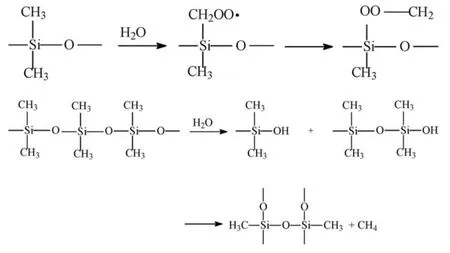

Fig.7.The atom ratios of element C,O and Si changed with temperature.
It can be seen from Table 1 that different temperatures show same phenomenon,that is,the proportion of C element decreased,the proportion of O and S elements increased.Moreover,with the increasing of temperature,this phenomenon becomes more obvious(Fig.7).It implies the oxidation of the molecular of silicone rubber.
3.6.Degradation mechanism
All the above-mentioned data are helpful for the prediction of the change of substances and the process of chemical degradation during the accelerated aging of the silicone rubber.
In the accelerated aging experiment,with the increase of temperature,the quality of rubber decreased more and more seriously,and the compression set increased,which indicated that the silicone rubber molecular degradation occurred;at the same time,the content of oxygen on the surface of the silicone rubber increased in the presence of water,and the side-chain groups on the main-chain oxidized gradually (formula 1),and finally dropped off in the form of small molecules of methyl.It can be inferred that with the increase of exposure time in the fuel cell environment,the macromolecules of rubber will gradually become shorter,its mechanical strength will become worse,and the sealing performance will decline.Fortunately,the dynamics of this process are very slow.The suggested path of the degradation of silicone rubber can be found in formula 1 and 2,which is also called chainscissoring.
4.Conclusion
A commercial available silicone rubber material,with high promising for the application in PEMFC,were investigated under accelerated aging conditions,including simulated and augmented PEMFC solution,elevated temperature,and also combined with compressive load.The following conclusions can be made.
(1) Compared with other factors,temperature is the most influential one.With temperature rising from 120°C to 180°C,the silicone rubber degraded more and more;
(2) SEM,Mass loss shows that surface roughness,pits,gullies,even debris can be expected during the degradation of the silicone rubber;
(4) As the most important indicator of its sealing performance,the compression set of the silicone rubber increases with temperature.
Therefore in the process of seal lifetime assessment,temperature can be used as the most important acceleration factor to greatly reduce the time required for assessment.Based on the most important indicator of the workability of a seal,i.e.compression set,which will degrade following Arrhenius formula,we can judge its lifetime in shortened period,since the degradation is proportional to a power of temperature.The result will be reported in another paper.
Declaration of competing interest
The authors declare that they have no known competing financial interests or personal relationships that could have appeared to influence the work reported in this paper.
Acknowledgements
This work was supported by China Ministry of Science and Technology(grant number 2016YFB0101320),and Science and Technology Commission of Shanghai Municipality (STCSM) (grant number 17DZ1200702 and 17DZ2292700).
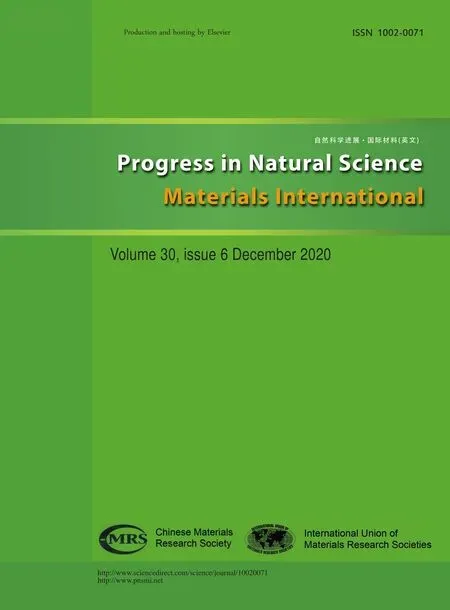 Progress in Natural Science:Materials International2020年6期
Progress in Natural Science:Materials International2020年6期
- Progress in Natural Science:Materials International的其它文章
- Key materials and technologies for fuel cells
- Experimental measurement of proton conductivity and electronic conductivity of membrane electrode assembly for proton exchange membrane fuel cells
- Nickel-introduced structurally ordered PtCuNi/C as high performance electrocatalyst for oxygen reduction reaction
- Large specific surface area S-doped Fe-N-C electrocatalysts derived from Metal-Organic frameworks for oxygen reduction reaction
- Surface modifications of Pt-based atomically ordered nanoparticles to improve catalytic performances for oxygen reduction reaction
- A novel graphite/phenolic resin bipolar plate modified by doping carbon fibers for the application of proton exchange membrane fuel cells
